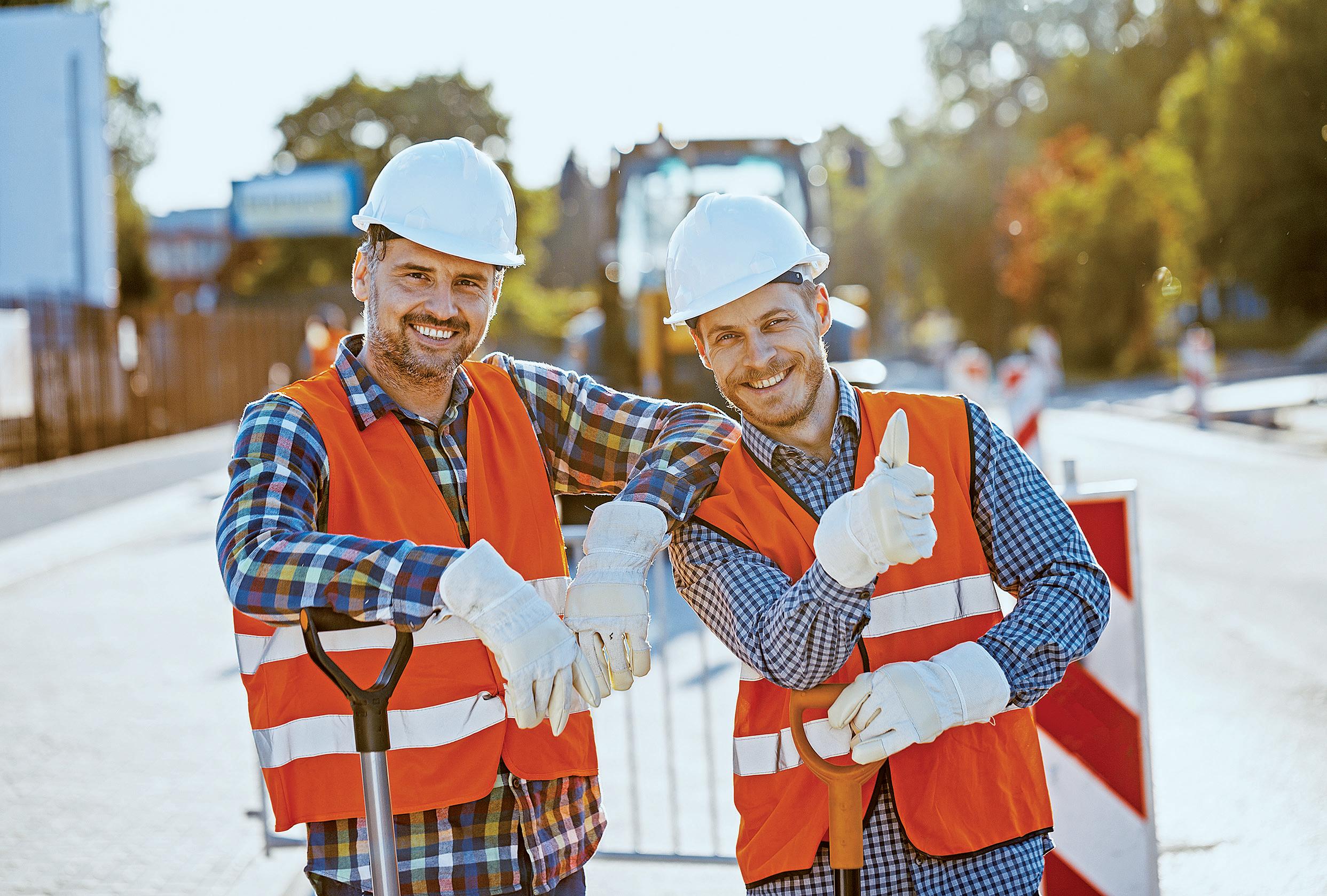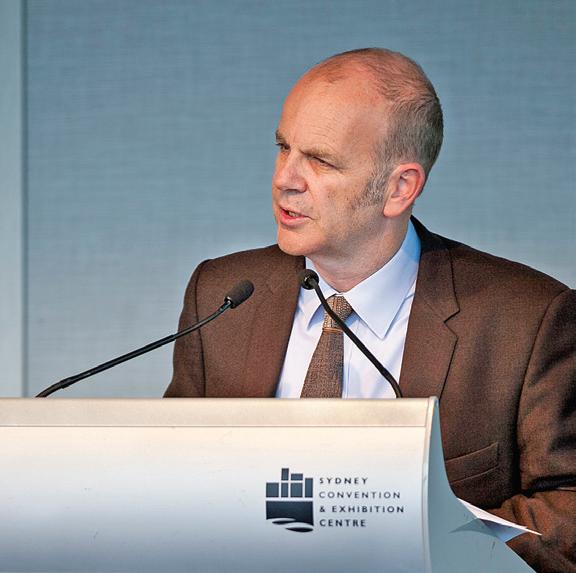
9 minute read
Mates in Construction NSW

Suicide Is No Longer A Dirty Word!
According to Mates In Construction NSW (MATES NSW), construction workers are more than two times more likely to die by suicide than Australian men. Indeed, young construction workers are almost six times more likely to die from suicide than workplace accidents.
MATES NSW is a charity set up to try and combat the terrible rate of suicide in the industry. According to CEO Brad Parker, 190 people in the construction industry take their own lives every year. The charity has reduced suicide by almost 8 per cent since its formation in 2009. “We have a straightforward model, but it’s very effective. We have created a network of carers who will assist people in identifying the signs of suicide and connecting those people to help,” Mr Parker says. “The Program uses the world’s best practices tailored into language that construction workers understand. The genius of construction industry management and employees came together for the common good of everybody on a site, to prevent suicide in the workplace,” he says. MATES NSW offers three areas of training across the industry: • General Awareness Training (GAT) — training is delivered to at least 80% of workers on-site and is delivered en masse and on-site. This training introduces workers to the nature of the problem, that it is okay to talk about mental health, and provides practical guidance on how they can assist. • Connector Training — provided to those people on site who volunteer to become a Connector — a person trained to help keep someone safe in a crisis while at the same time connecting them to professional help. • Applied Suicide Intervention Skills Training (ASIST) — equips individuals to become ASIST workers, comparable to the first aid officer on-site. ASIST workers will talk to a person contemplating suicide to make this person ‘safe’. Using simple skills, an ASIST worker will listen to the person’s concerns and respond to them appropriately to reach a ‘safe plan’.
Brad Parker, CEO Mates NSW
“It’s mates looking out for mates and mates helping mates. It goes further than preventing suicide attempts — our Program develops a caring sanctuary for those with depression or mental health issues,” Mr Parker says. Many factors contribute to suicidal thoughts, including long working hours, job insecurity, bullying, financial concerns, relationship issues, and a higher rate of drug and alcohol abuse within the industry. “We also need to remove the stigma surrounding mental health issues, which causes people to try to cover up thoughts of suicide,” Mr Parker says. Projects like Mates In Construction, Mates in Mining, and Mates in Energy are all working towards reducing the suicide rate, but there is a need for higher funding levels. As Mr Parker says: “Take-up of the service in NSW is currently outstripping supply significantly, where the service is not actively promoted… additionally, our work experience in regional NSW has confirmed a significant need for service rollout, with high levels of lived experience of suicide in each session delivered.” Suicide in the Australian construction industry costs the economy more than $1.5 billion a year. However, over the past 10-15 years, we’ve seen increased investment in mental health at the state and federal levels. Master Builders NSW is currently facilitating the Suicide Prevention Gatekeepers Training workshops (Connector and ASIST) in partnership with MATES NSW. The NSW Ministry of Health has funded the two-year Program since 2020. Master Builders NSW aims to deliver the Suicide Prevention Gatekeepers Training workshops amongst 3000 construction workers in Sydney. Master Builders NSW Suicide Prevention Gatekeepers Training workshops target the following cohorts: • young apprentices; • support staff (business trainees, new entrants); and • apprentice mentors (Supervisors, Project
Managers, etc.) • others working in or connected to the
Building & Construction Industry Executive Director of Master Builders NSW, Brian Seidler, says the Program is a giant leap forward for the building and construction industry, with significantly higher rates of suicide and mental health issues amongst workers than in other sectors. “Mental health and suicide prevention is everyone’s business, and when all of us look out for our mates, we are protecting the most important commodity in our industry — its people.” “In the building and construction industry, suicide seems to be a part of the reality — the sector is highly transient, with most workers employed on a project by project basis, for periods from a few weeks to a few years,” he said. “We need to ensure the industry represents a sustainable and safe workplace which attracts and keeps workers on their career pathways and mental health training is a critical part of that.”

Facts About Suicide Worldwide
According to World Health Organisation, 703,000 people take their own lives every year, and many more people attempt suicide. Every suicide is a tragedy that affects families, communities and entire countries and has longlasting effects on the people left behind. Suicide occurred throughout the lifespan and was the fourth leading cause of death among 15-29 year-olds globally in 2019. Suicide does not just occur in high-income countries but is a global phenomenon globally. Over 77% of global suicides occurred in low- and middle-income countries in 2019.
Brian Seidler
The New South Wales Suicide Monitoring System collaborates with NSW Health, the Department of Communities and Justice (DCJ), the State Coroner, and the NSW Police established in October 2020. NSW Health publishes monthly reports on suspected deaths by suicide occurring in New South Wales. The latest report for January 2022 found 928 suspected deaths by suicide in New South Wales in 2021, which is higher than the number of deaths reported for 2020 (904) but lower than for 2019 (945) (NSW Health 2022). Over 10 million Australian adults are estimated to know someone who has died by suicide, and 1 in 2 young people are impacted by suicide by the time they turn 25. The latest Australian Bureau of Statistics (ABS) data shows that around nine (9) lives are lost per day to suicide. These statistics are based on 2020 data released by the Australian Bureau of Statistics on 29 September 2021. • 3,139 Australians died by suicide in 2020, representing an age-standardised suicide death rate of 12.1 per 100,000 people. • This is a decrease of around 6.6% compared with the 12.9 age-standardised suicide death rate reported for 2019. • However, over the previous ten years, the age-standardised suicide death rate per 100,000 people has increased from 10.5 in 2011 to 12.1 in 2020, an increase of 15.2%. • Suicide was the 15th most common cause of death overall (down from 13th in 2019), accounting for 1.9% of deaths. • The median age of death by suicide was 43.5 years, compared to 81.7 years for all causes of death. Because suicide frequently occurs at a younger age than other causes of death, the potential years of life lost are high.
As in previous years, in 2020, suicide was the cause of death, resulting in the highest number of potential years of life lost: 109,525 years. This was more than half again (57.7%) as many years higher as the next most significant cause.
Younger Australians
• In 2020, 454 young people aged 15-24 died by suicide, representing 21.2 deaths by suicide per 100,000 people. Over one-third of deaths in 15-24-year-olds are due to suicide.


TAFE NSW Trade Teachers attending the ASIST workshop. From left – Back row: Michael Rudd, Shane Judd, William Guthrie, Rudi Meuwissen, Christopher Neal, Richard Bailey, Patrick Aiken. Front Row – from left: Josef Fritzer, Akash Chauhan.
• Suicide was the most common cause of death for adults aged 15-44, with 1,612 deaths by suicide in this group.
Men
• Consistent with previous years, males are three times more likely to die by suicide than females. Males accounted for 75.9% of deaths by suicide (2,384 deaths); this represents an age-standardised suicide death rate of 18.6 per 100,000 people (compared with a rate of 5.8 for females). • Men over 85 are particularly impacted, with 36.2 deaths by suicide per 100,000. • Aboriginal and Torres Strait Islander Peoples • In 2020 there were 223 Aboriginal and Torres
Strait Islander peoples died by suicide. • The median age of death by suicide of
Aboriginal and Torres Strait Islander peoples was 31.3 years, more than a decade younger than the median age of death by suicide for the general population of 43.5 years.
Region
• When looking at State and Territory data,
Northern Territory had the highest agestandardised rate of deaths by suicide at 20 per 100,000. • All states except Northern Territory and the
Australian Capital Territory had decreases in the number of suicides between 2019 and 2020. • Age-standardised rates of death by suicide were higher in regional Australia: 15.7 deaths per 100,000 outside capital cities, compared with 10.3 deaths per 100,000 in capital cities. • The most significant difference was in
Western Australia, with an age-standardised death by a suicide rate of 12.7 per 100,000 in Greater Perth, compared with 20.8 per 100,000 in the rest of the state.
Risk Factors
• In 2020, over 90% of people who died by suicide had at least one risk factor reported.
Both mental and behavioural disorders and psychosocial risk factors were present in over two-thirds of deaths of people who died by suicide. People who died by suicide had an average of 3-4 risk factors. • The proportion of suicide deaths recording at least one psychosocial risk factor was 67.1%. • The three most frequently occurring psychosocial risk factors for men were: a personal history of self-harm (19.5% of deaths by suicide), disruption of a family by separation and divorce (14%), and problems in a relationship with a spouse or partner (11.8%). • The three most frequently occurring psychosocial risk factors for women were: a personal history of self-harm (32.8% of
deaths by suicide), problems in a relationship with a spouse or partner (10.9%), and disappearance or death of a family member (9.7).
Other statistics
• 65,000 suicide attempts each year (est.) • It is estimated that more than 500,000
Australians have attempted suicide at some time in their life. Master Builders NSW would like to take this opportunity to thank the team from MATES NSW, Brad Parker, Heather Drew, Kayte Wilson and Andrew Bate for their ongoing support in the rollout of the Master Builders NSW Gatekeepers Program. Master Builders NSW will deliver the FREE Suicide Prevention Gatekeepers Training workshop every month till November 2022. Master Builders NSW members and their employees will be notified via an e-circular of the upcoming dates. For further enquiries, contact Omesh Jethwani, Government Projects & Programs Manager, on 02 8586 3539. If you need support in the industry, please contact your Employee Assistance Program (EAP) or call the MATES NSW hotline on 1300 642 111. Issue Two | April-June 2022 | MBA NSW 29


